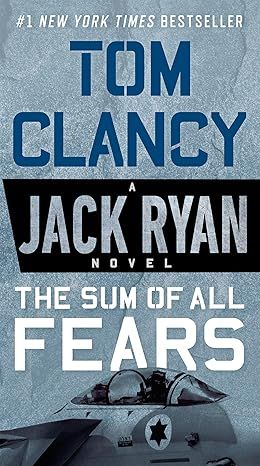The Sum of All Fears (A Jack Ryan Novel)
4.6
-
4,247 ratings
Don't Miss the Original Series Tom Clancy's Jack Ryan Starring John Krasinski!
The search for a stolen nuclear weapon on American soil sends Jack Ryan on a dangerous mission with global consequences in this #1 New York Times bestselling thriller.
Peace may finally be at hand in the Middle East, as Jack Ryan, Deputy Director of Intelligence for the CIA, lays the groundwork for a plan that could end centuries of conflict. But ruthless terrorists have a final, desperate card to play: a nuclear weapon hidden somewhere in the United States.
With one terrible act, distrust mounts, forces collide, and the floundering U.S. president seems unable to cope with the crisis. With the world on the verge of nuclear disaster, Ryan must frantically seek a solution—before the chiefs of state lose control of themselves and the world.
Kindle
$9.99
Available instantly
Audiobook
$0.00
with membership trial
Hardcover
$21.72
Paperback
$10.39
Ships from
Amazon.com
Payment
Secure transaction
ISBN-10
0451489810
ISBN-13
978-0451489814
Print length
1216 pages
Language
English
Publisher
Berkley
Publication date
June 04, 2018
Dimensions
4.19 x 1.81 x 7.5 inches
Item weight
1.35 pounds
Popular highlights in this book
A nation achieves greatness by helping others to make peace, not by demonstrating prowess at war or commerce.
Highlighted by 259 Kindle readers
What is the work of genius the first time is the work of a tinsmith soon thereafter.
Highlighted by 252 Kindle readers
Prosperity was the handmaiden of peace, and the assassin of discontent.
Highlighted by 244 Kindle readers
Product details
ASIN :
B001Q9J4QA
File size :
2623 KB
Text-to-speech :
Enabled
Screen reader :
Supported
Enhanced typesetting :
Enabled
X-Ray :
Enabled
Word wise :
Enabled
Editorial reviews
Praise for The Sum of All Fears
“A whiz-bang page-turner!”—The New York Times Book Review
“The Sum of All Fears delivers!”—People
“A nonstop roller coaster ride to a nail-biting climax...ingenious.”—Publishers Weekly
“Tom Clancy at his best...This is a book not to be missed.”—Dallas Morning News
Praise for Tom Clancy
“He constantly taps the current world situation for its imminent dangers and spins them into an engrossing tale.”—The New York Times Book Review
“A brilliant describer of events.”—The Washington Post
“No one can equal his talent for making military electronics and engineering intelligible and exciting...He remains the best!”—Houston Chronicle
Sample
PROLOGUE
BROKEN ARROW
“Like the wolf on the fold.” In recounting the Syrian attack on the Israeli-held Golan Heights at 1400 local time on Saturday, the 6th of October, 1973, most commentators automatically recalled Lord Byron’s famous line. There is also little doubt that that is precisely what the more literarily inclined Syrian commanders had in mind when they placed the final touches on the operations plans that would hurl more tanks and guns at the Israelis than any of Hitler’s vaunted panzer generals had ever dreamed of having.
However, the sheep found by the Syrian Army that grim October day were more like big-horned rams in autumn rut than the more docile kind found in pastoral verse. Outnumbered by roughly nine to one, the two Israeli brigades on the Golan were crack units. The 7th Brigade held the northern Golan and scarcely budged, its defensive network a delicate balance of rigidity and flexibility. Individual strongpoints held stubbornly, channeling the Syrian penetrations into rocky defiles where they could be pinched off and smashed by roving bands of Israeli armor which lay in wait behind the Purple Line. By the time reinforcements began arriving on the second day, the situation was still in hand—but barely. By the end of the fourth day, the Syrian tank army that had fallen upon the 7th lay a smoking ruin before it.
The Barak (“Thunderbolt”) Brigade held the southern heights and was less fortunate. Here the terrain was less well suited to the defense, and here also the Syrians appear to have been more ably led. Within hours the Barak had been broken into several fragments. Though each piece would later prove to be as dangerous as a nest of vipers, the Syrian spearheads were quick to exploit the gaps and race toward their strategic objective, the Sea of Galilee. The situation that developed over the next thirty-six hours would prove to be the gravest test of Israeli arms since 1948.
Reinforcements began arriving on the second day. These had to be thrown into the battle area piecemeal—plugging holes, blocking roads, even rallying units that had broken under the desperate strain of combat and, for the first time in Israeli history, fled the field before the advancing Arabs. Only on the third day were the Israelis able to assemble their armored fist, first enveloping, then smashing the three deep Syrian penetrations. The changeover to offensive operations followed without pause. The Syrians were hurled back toward their own capital by a wrathful counterattack, and surrendered a field littered with burned-out tanks and shattered men. At the end of this day the troopers of the Barak and the 7th heard over their unit radio nets a message from Israeli Defense Forces High Command:
YOU HAVE SAVED THE PEOPLE OF ISRAEL.
And so they had. Yet outside Israel, except for schools in which men learn the profession of arms, this epic battle is strangely unremembered. As in the Six Day War of 1967, the more freewheeling operations in the Sinai were the ones that attracted the excitement and admiration of the world: bridging the Suez, the Battle of the “Chinese” Farm, the encirclement of the Egyptian 3rd Army—this despite the fearful implications of the Golan fighting, which was far closer to home. Still, the survivors of those two brigades knew what they had done, and their officers could revel in the knowledge that among professional soldiers who know the measure of skill and courage that such a stand entails, their Battle for the Heights would be remembered with Thermopylae, Bastogne, and Gloucester Hill.
Each war knows many ironies, however, and the October War was no exception. As is true of most glorious defensive stands, this one was largely unnecessary. The Israelis had misread intelligence reports which, had they been acted on as little as twelve hours earlier, would have enabled them to execute pre-set plans and pour reserves onto the Heights hours before the onslaught commenced. Had they done so, there would have been no heroic stand. There would have been no need for their tankers and infantrymen to die in numbers so great that it would be weeks before the true casualty figures were released to a proud but grievously wounded nation. Had the information been acted upon, the Syrians would have been massacred before the Purple Line for all their lavish collection of tanks and guns—and there is little glory in massacres. This failure of intelligence has never been adequately explained. Did the fabled Mossad fail so utterly to discern the Arabs’ plans? Or did Israeli political leaders fail to recognize the warnings they received? These questions received immediate attention in the world press, of course, most particularly in regard to Egypt’s assault-crossing of the Suez, which breached the vaunted Bar-Lev Line.
Equally serious but less well appreciated was a more fundamental error made years earlier by the usually prescient Israeli general staff. For all its firepower, the Israeli Army was not heavily outfitted with tube artillery, particularly by Soviet standards. Instead of heavy concentrations of mobile field guns, the Israelis chose to depend heavily on large numbers of short-range mortars, and attack aircraft. This left Israeli gunners on the Heights outnumbered twelve to one, subject to crushing counter-battery fire, and unable to provide adequate support to the beleaguered defenders. That error cost many lives.
As is the case with most grave mistakes, this one was made by intelligent men, for the very best of reasons. The same attack-fighter that struck the Golan could rain steel and death on the Suez as little as an hour later. The IAF was the first modern air force to pay systematic attention to “turn-around time.” Its ground crewmen were trained to act much like a racing car’s pit crew, and their speed and skill effectively doubled each plane’s striking power, making the IAF a profoundly flexible and weighted instrument. And making a Phantom or a Skyhawk appear to be more valuable than a dozen mobile field guns.
What the Israeli planning officers had failed to take fully into account was the fact that the Soviets were the ones arming the Arabs, and, in doing so, would inculcate their clients with their own tactical philosophies. Intended to deal with NATO air power always deemed better than their own, Soviet surface-to-air missile (SAM) designers had always been among the world’s best. Russian planners saw the coming October War as a splendid chance to test their newest tactical weapons and doctrine. They did not spurn it. The Soviets gave their Arab clients a SAM network such as the North Vietnamese or Warsaw Pact forces of the time dared not dream about, a nearly solid phalanx of interlocking missile batteries and radar systems deployed in depth, along with new mobile SAMs that could advance with the armored spearheads, extending the “bubble” of counter-air protection under which ground action could continue without interference. The officers and men who were to operate those systems had been painstakingly trained, many within the Soviet Union with the full benefit of everything the Soviets and Vietnamese had learned of American tactics and technology, which the Israelis were correctly expected to imitate. Of all the Arab soldiers in the October War, only these men would achieve their pre-war objectives. For two days they effectively neutralized the IAF. Had ground operations gone according to plan, that would have been enough.
And it is here that the story has its proper beginning. The situation on the Golan Heights was immediately evaluated as serious. The scarce and confused information coming in from the two stunned brigade staffs led Israeli High Command to believe that tactical control of the action had been lost. It seemed that their greatest nightmare had finally occurred: they had been caught fatally unready; their northern kibbutzim were vulnerable; their civilians, their children lay in the path of a Syrian armored force that by all rights could roll down from the Heights with the barest warning. The initial reaction of the staff operations officers was something close to panic.
But panic is something that good operations officers also plan for. In the case of a nation whose enemies’ avowed objective was nothing short of physical annihilation, there was no defensive measure that could be called extreme. As early as 1968, the Israelis, like their American and NATO counterparts, had based their ultimate plan on the nuclear option. At 03:55 hours, local time, on October 7th, just fourteen hours after the actual fighting began, the alert orders for OPERATION JOSHUA were telexed to the IAF base outside Beersheba.
Israel did not have many nuclear weapons at the time—and denies having any to this date. Not that many would be needed, if it came to that. At Beersheba, in one of the countless underground bomb-storage bunkers, were twelve quite ordinary-looking objects, indistinguishable from the many other items designed to be attached to tactical aircraft except for the silver-red striped labels on their sides. No fins were attached, and there was nothing unusual in the streamlined shape of the burnished-brown aluminum skin, with barely visible seams and a few shackle points. There was a reason for that. To an unschooled or cursory observer, they might easily have been mistaken for fuel tanks or napalm canisters, and such objects hardly merit a second look. But each was a plutonium fission bomb with a nominal yield of 60 kilotons, quite enough to carve the heart out of a large city, or to kill thousands of troops in the field, or, with the addition of cobalt jackets—stored separately but readily attachable to the external skin—to poison a landscape to all kinds of life for years to come.
On this morning, activity at Beersheba was frantic. Reserve personnel were still streaming into the base from the previous day’s devotions and family-visiting all over the small country. Those men on duty had been so for too long a time for the tricky job of arming aircraft with lethal ordnance. Even the newly arriving men had had precious little sleep. One team of ordnancemen, for security reasons not told the nature of their task, was arming a flight of A-4 Skyhawk strike-fighters with nuclear weapons under the eyes of two officers, known as “watchers,” for that was their job, to keep visual track of everything that had to do with nuclear weapons. The bombs were wheeled under the centerline hardpoint of each of the four aircraft, lifted carefully by the hoisting arm, then shackled into place. The least exhausted of the ground crew might have noticed that the arming devices and tail fins had not yet been attached to the bombs. If so, they doubtless concluded that the officer assigned to that task was running late—as was nearly everything this cold and fateful morning. The nose of each weapon was filled with electronics gear. The actual exploder mechanism and capsule of nuclear material—collectively known as “the physics package”—were already in the bombs, of course. The Israeli weapons, unlike American ones, were not designed to be carried by alert aircraft during time of peace, and they lacked the elaborate safeguards installed in American weapons by the technicians at the Pantex assembly plant, outside Amarillo, Texas. The fusing systems comprised two packages, one for attachment to the nose, and one integral with the tail fins. These were stored separately from the bombs themselves. All in all, the weapons were very unsophisticated by American or Soviet standards, in the same sense that a pistol is far less sophisticated than a machine gun, but, at close range, equally lethal.
Once the nose and fin packages were installed and activated, the only remaining activation procedure was the installation of a special arming panel within the cockpit of each fighter, and the attachment of the power plug from the aircraft to the bomb. At that point the bomb would be “released to local control,” placed in the hands of a young, aggressive pilot, whose job was then to loft it in a maneuver called The Idiot’s Loop, which tossed the bomb on a ballistic path that would—probably—allow him and his aircraft to escape without harm when the bomb detonated.
Depending on the exigencies of the moment and the authorization of the “watchers,” Beersheba’s senior ordnance officer had the option to attach the arming packages. Fortunately, this officer was not at all excited about the idea of having half-live “nukes” sitting about on a flight line that some lucky Arab might attack at any moment. A religious man, for all the dangers that faced his country on that cold dawn, he breathed a silent prayer of thanks when cooler heads prevailed in Tel Aviv, and gave the order to stand JOSHUA down. The senior pilots who would have flown the strike mission returned to their squadron ready-rooms and forgot what they had been briefed to do. The senior ordnance officer immediately ordered the bombs removed and returned to their place of safekeeping.
The bone-tired ground crew began removing the weapons just as other teams arrived on their own carts for the task of rearming the Skyhawks with Zuni rocket clusters. The strike order had been put up: The Golan. Hit the Syrian armored columns advancing on the Barak’s sector of Purple Line from Kafr Shams. The ordnancemen jostled under the aircraft, two teams each trying to do their jobs, one team trying to remove bombs that they didn’t know to be bombs at all, while the other hung Zunis on the wings.
There were more than four strike aircraft cycling through Beersheba, of course. The dawn’s first mission over the Suez was just returning—what was left of it. The RF-4C Phantom reconnaissance aircraft had been lost, and its F-4E fighter escort limped in trailing fuel from perforated wing tanks and with one of its two engines disabled. The pilot had already radioed his warning in: there was some new kind of surface-to-air missile, maybe that new SA-6; its radar-tracking systems had not registered on the Phantom’s threat-receiver; the recce bird had had no warning at all, and only luck had enabled him to evade the four targeted on his aircraft. That fact was flashed to IAF high command even before the aircraft touched down gingerly on the runway. The plane was directed to taxi down to the far end of the ramp, close to where the Skyhawks stood. The Phantom’s pilot followed the jeep to the waiting firefighting vehicles, but just as it stopped, the left main tire blew out. The damaged strut collapsed as well, and 45,000 pounds of fighter dropped to the pavement like dishes from a collapsed table. Leaking fuel ignited, and a small but deadly fire enveloped the aircraft. An instant later, 20mm ammunition from the fighter’s gun pod started cooking off, and one of the two crewmen was screaming within the mass of flames. Firefighters moved in with water-fog. The two “watcher” officers were the closest, and raced toward the flames to drag the pilot clear. All three were peppered by fragments from the exploding ammunition, while a fireman coolly made his way through the flames to the second crewman and carried him out, singed but alive. Other firemen collected the watchers and the pilot and loaded their bleeding bodies into an ambulance.
Read more
About the authors
Tom Clancy
Tom Clancy is America's, and the world's, favorite international thriller author. Starting with THE HUNT FOR RED OCTOBER, all thirteen of his previous books have hit #1 on the New York Times bestseller list. His books, THE HUNT FOR RED OCTOBER, PATRIOT GAMES, CLEAR AND PRESENT DANGER and THE SUM OF ALL FEARS have been made into major motion pictures. He lived in Maryland where he was a co-owner of the Baltimore Orioles.
Read more
Reviews
Customer reviews
4.6 out of 5
4,247 global ratings
marilyn priddy
5
Intriguing
Reviewed in the United States on October 13, 2023
Verified Purchase
As all of the Jack Ryan series written by Clancy, this is a page turner, detailed, well written, hard to put down. A must read.
2 people found this helpful
Diana Vermaas
5
The Sum of All Fears
Reviewed in the United States on January 10, 2024
Verified Purchase
It was a riveting read. Hard to put down. Characters were well developed. Several story lines were juggled without losing continuity. The only minus to me was the detail on scientific explanation of the workings of the bomb. It was interesting but almost went on too long for me. However, some might enjoy this and find it educational. Good read and excellent as all Tom Clancy's books are.
Read more
2 people found this helpful
Dave Johnston
5
Great Product!
Reviewed in the United States on August 22, 2023
Verified Purchase
Tom Clancy (and others) wrote an excellent series - Jack Ryan. Buy all 37 books today. This book was part of an order. All books were new and arrived in pristine condition. Great job!!
Best sellers
View all
The Tuscan Child
4.2
-
100,022
$8.39

The Thursday Murder Club: A Novel (A Thursday Murder Club Mystery)
4.3
-
155,575
$6.33

Sapiens: A Brief History of Humankind
4.6
-
140,302
$13.49

The Butterfly Garden (The Collector, 1)
4.3
-
88,556
$9.59

Things We Hide from the Light (Knockemout Series, 2)
4.4
-
94,890
$11.66

The Last Thing He Told Me: A Novel
4.3
-
154,085
$2.99

The Perfect Marriage: A Completely Gripping Psychological Suspense
4.3
-
143,196
$9.47

The Coworker
4.1
-
80,003
$13.48

First Lie Wins: A Novel (Random House Large Print)
4.3
-
54,062
$14.99

Mile High (Windy City Series Book 1)
4.4
-
59,745
$16.19

Layla
4.2
-
107,613
$8.99

The Locked Door
4.4
-
94,673
$8.53

